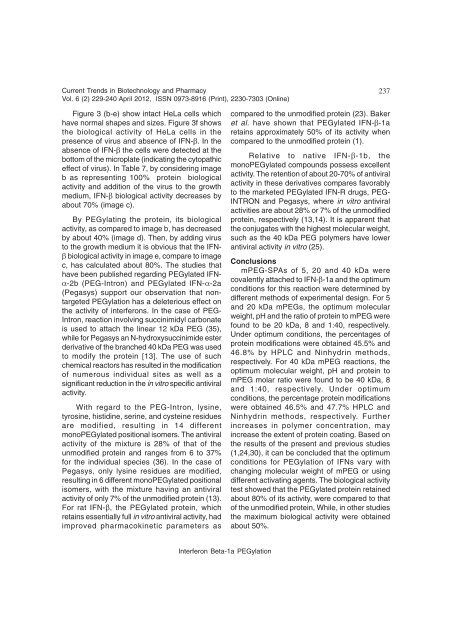d(GC) - Association of Biotechnology and Pharmacy
d(GC) - Association of Biotechnology and Pharmacy
d(GC) - Association of Biotechnology and Pharmacy
Create successful ePaper yourself
Turn your PDF publications into a flip-book with our unique Google optimized e-Paper software.
Current Trends in <strong>Biotechnology</strong> <strong>and</strong> <strong>Pharmacy</strong><br />
Vol. 6 (2) 229-240 April 2012, ISSN 0973-8916 (Print), 2230-7303 (Online)<br />
Figure 3 (b-e) show intact HeLa cells which<br />
have normal shapes <strong>and</strong> sizes. Figure 3f shows<br />
the biological activity <strong>of</strong> HeLa cells in the<br />
presence <strong>of</strong> virus <strong>and</strong> absence <strong>of</strong> IFN-β. In the<br />
absence <strong>of</strong> IFN-β the cells were detected at the<br />
bottom <strong>of</strong> the microplate (indicating the cytopathic<br />
effect <strong>of</strong> virus). In Table 7, by considering image<br />
b as representing 100% protein biological<br />
activity <strong>and</strong> addition <strong>of</strong> the virus to the growth<br />
medium, IFN-β biological activity decreases by<br />
about 70% (image c).<br />
By PEGylating the protein, its biological<br />
activity, as compared to image b, has decreased<br />
by about 40% (image d). Then, by adding virus<br />
to the growth medium it is obvious that the IFNβ<br />
biological activity in image e, compare to image<br />
c, has calculated about 80%. The studies that<br />
have been published regarding PEGylated IFNα-2b<br />
(PEG-Intron) <strong>and</strong> PEGylated IFN-α-2a<br />
(Pegasys) support our observation that nontargeted<br />
PEGylation has a deleterious effect on<br />
the activity <strong>of</strong> interferons. In the case <strong>of</strong> PEG-<br />
Intron, reaction involving succinimidyl carbonate<br />
is used to attach the linear 12 kDa PEG (35),<br />
while for Pegasys an N-hydroxysuccinimide ester<br />
derivative <strong>of</strong> the branched 40 kDa PEG was used<br />
to modify the protein [13]. The use <strong>of</strong> such<br />
chemical reactors has resulted in the modification<br />
<strong>of</strong> numerous individual sites as well as a<br />
significant reduction in the in vitro specific antiviral<br />
activity.<br />
With regard to the PEG-Intron, lysine,<br />
tyrosine, histidine, serine, <strong>and</strong> cysteine residues<br />
are modified, resulting in 14 different<br />
monoPEGylated positional isomers. The antiviral<br />
activity <strong>of</strong> the mixture is 28% <strong>of</strong> that <strong>of</strong> the<br />
unmodified protein <strong>and</strong> ranges from 6 to 37%<br />
for the individual species (36). In the case <strong>of</strong><br />
Pegasys, only lysine residues are modified,<br />
resulting in 6 different monoPEGylated positional<br />
isomers, with the mixture having an antiviral<br />
activity <strong>of</strong> only 7% <strong>of</strong> the unmodified protein (13).<br />
For rat IFN-β, the PEGylated protein, which<br />
retains essentially full in vitro antiviral activity, had<br />
improved pharmacokinetic parameters as<br />
Interferon Beta-1a PEGylation<br />
237<br />
compared to the unmodified protein (23). Baker<br />
et al. have shown that PEGylated IFN-β-1a<br />
retains approximately 50% <strong>of</strong> its activity when<br />
compared to the unmodified protein (1).<br />
Relative to native IFN-β-1b, the<br />
monoPEGylated compounds possess excellent<br />
activity. The retention <strong>of</strong> about 20-70% <strong>of</strong> antiviral<br />
activity in these derivatives compares favorably<br />
to the marketed PEGylated IFN-R drugs, PEG-<br />
INTRON <strong>and</strong> Pegasys, where in vitro antiviral<br />
activities are about 28% or 7% <strong>of</strong> the unmodified<br />
protein, respectively (13,14). It is apparent that<br />
the conjugates with the highest molecular weight,<br />
such as the 40 kDa PEG polymers have lower<br />
antiviral activity in vitro (25).<br />
Conclusions<br />
mPEG-SPAs <strong>of</strong> 5, 20 <strong>and</strong> 40 kDa were<br />
covalently attached to IFN-β-1a <strong>and</strong> the optimum<br />
conditions for this reaction were determined by<br />
different methods <strong>of</strong> experimental design. For 5<br />
<strong>and</strong> 20 kDa mPEGs, the optimum molecular<br />
weight, pH <strong>and</strong> the ratio <strong>of</strong> protein to mPEG were<br />
found to be 20 kDa, 8 <strong>and</strong> 1:40, respectively.<br />
Under optimum conditions, the percentages <strong>of</strong><br />
protein modifications were obtained 45.5% <strong>and</strong><br />
46.8% by HPLC <strong>and</strong> Ninhydrin methods,<br />
respectively. For 40 kDa mPEG reactions, the<br />
optimum molecular weight, pH <strong>and</strong> protein to<br />
mPEG molar ratio were found to be 40 kDa, 8<br />
<strong>and</strong> 1:40, respectively. Under optimum<br />
conditions, the percentage protein modifications<br />
were obtained 46.5% <strong>and</strong> 47.7% HPLC <strong>and</strong><br />
Ninhydrin methods, respectively. Further<br />
increases in polymer concentration, may<br />
increase the extent <strong>of</strong> protein coating. Based on<br />
the results <strong>of</strong> the present <strong>and</strong> previous studies<br />
(1,24,30), it can be concluded that the optimum<br />
conditions for PEGylation <strong>of</strong> IFNs vary with<br />
changing molecular weight <strong>of</strong> mPEG or using<br />
different activating agents. The biological activity<br />
test showed that the PEGylated protein retained<br />
about 80% <strong>of</strong> its activity, were compared to that<br />
<strong>of</strong> the unmodified protein, While, in other studies<br />
the maximum biological activity were obtained<br />
about 50%.













